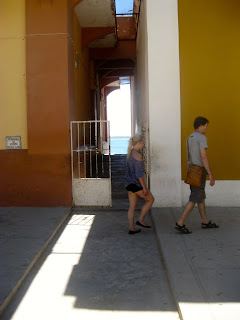Under Five Mortality Rate
June, 2010
June, 2010
I remember
the panicked look on her older brother’s face as he rushed into the hospital,
cradling his unconscious sister in his arms. “Me sistah noh well. We need hep.”
he said in Krio, the local language of Sierra Leone, and placed her on the
small exam table that we had in triage- the area under the landing in the Ola
During Children’s Hospital in Freetown. Her head flopped back like that of a
rag doll. After confirming she had a pulse, I scooped her up in my arms,
carefully supporting her head, and weaved through the crowd blocking the route
to the ER. As I burst through the doors, I scanned the room for an empty bed
while calling for a doctor’s help. As I lay her down and grabbed a pulse
oximeter from a nearby nurse, I noticed her breathing becoming increasingly
shallow. I took her vitals but she barely had a pulse. And then she stopped
breathing. The doctor barked at me to get a resuscitator. Holding the bag, I
pumped oxygen into her lungs and the doctor pressed down on her chest. Perhaps
my eyes were trying to fool my brain, but I could have sworn that I saw her
take one last breath. But instead of her pulse rising, a white substance came
oozing out of her nose and mouth. Another attempt to revive her yielded similar
results. The doctor shook his head sadly and called time of death before moving
on to the next patient, a little boy who was convulsing as a result of
untreated (and what would be fatal) malaria.
I was left
standing next to the girl, my hands shaking, willing myself not to burst into
tears.
In that
moment, I wanted nothing more than to go home, lay in my bed, put my head in my
pillow and cry. I wanted to buy the next ticket back to New York and to never
look back, to forget everything I had learned, to erase the face of that little
girl from my mind and to block out the sadness that was overwhelming me. I
wanted to undo everything-to rewind to that day when I was nine and had so
proudly and confidently announced that I was to become the Secretary-General of
the United Nations. I wanted to take back the summer of 2002 in Tajikistan and
Uzbekistan, the teaching job in Rwanda, the memories of the orphanage in
Vietnam. I wanted to unlearn everything I knew about development and the
economics of growth that persisted in reminding me that change would be slow. I
wanted to purge myself of all the dinner conversations with the heads of UN
agencies in Sierra Leone and with NGO workers I had befriended. I wanted to
free my mind of the debates I had entangled myself in about the very merits of
the sector that seemed to have long ago sucked me in.
Instead I
turned away from the bed and away from the girl and slowly walked out of the
ER, past the nurses hurrying about with syringes and bandages and oxygen tubes,
through the throng of hysterical parents, down the concrete ramp and back to
the cramped and ill equipped triage to resume my duties. Eventually the girl’s parents
came; the sobbing mother had the colorful cloth with her that I knew would act
as a shroud and indeed later, the father emerged with a little bundle.
Returning
to New York and suddenly being surrounded by running water, reliable
electricity, paved roads, fire trucks and the expectation that, bar some freak
accident, we’d survive to celebrate our 40th birthdays, was jarring. I had a
hard time in the dark, from which the forms of the youngest victims of the
decrepit healthcare system emerged and I wasn’t entirely comfortable with
absolute silence when the heartbroken wails of parents echoed in my brain.
Colorful curtains forced images of the makeshift coffins from the deep recesses
of my mind straight into my vision and intruding my thoughts and sensibilities.
But
sitting in class at New York University, where I went at the time, and
wandering around Washington Square Park seemed foreign and empty. My classmates
were thrilled to be at NYU, titillated to take advantage of the sudden freedom
that college offered and anxious for classes. I wouldn’t describe myself as
jaded nor would I assert that somehow college wasn’t new and exciting for me
too; it was. But the life I had left behind in Sierra Leone wouldn’t let me
return to the life that I had lived in New York. Even more than my previous
exposures to the developing world, Sierra Leone left me with the unwavering
feeling that I would never be able to rest easy while idle.
The
metrics of development aren’t merely statistics- I know what an under-5
mortality of 192 feels like.
------------------------------------------
If this is your first time here, check out my Introduction to the Blog and Introduction to Africa.
If this is your first time here, check out my Introduction to the Blog and Introduction to Africa.









